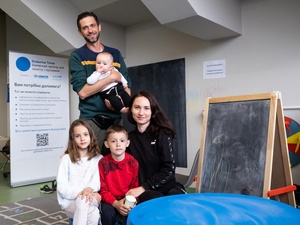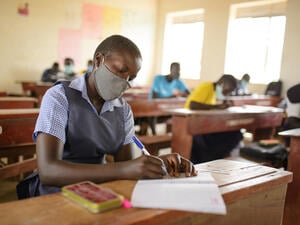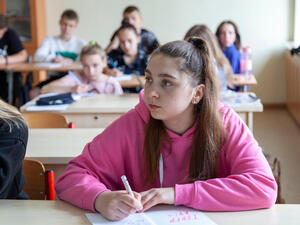UNHCR warm clothes put smiles on faces of quake-hit children
UNHCR warm clothes put smiles on faces of quake-hit children

Children in Danna village now have warm clothing to help them fend off the biting winds of winter and bitter cold.
DANNA VILLAGE, Muzaffarabad, Pakistan, Jan 9 (UNHCR) - As winter tightens its grip on the earthquake-affected mountainous areas near Muzaffarabad in Pakistan-administered Kashmir, the UN refugee agency's community services staff are distributing warm clothing to vulnerable young earthquake survivors.
In Danna village, some 30 kilometres north of Muzaffarabad city, children who were noted on a previous visit as suffering hardship through poverty, or being an orphan or disabled have had warm clothes distributed to them over the weekend.
"During our last visit to this village we realized that most of the children did not have adequate warm clothing to stay warm in these cold conditions. We arranged for some warm clothes and are on our way to distribute these in the village," said Catherine Harding, a UNHCR community services officer based in Muzaffarabad.
After negotiating the way through the curved mountainous roads of Pakistan-administered Kashmir in a 4-wheel-drive (4WD) vehicle and narrowly escaping a landslide, the UN refugee agency team stops near a group of UNHCR tents. Chaudry Sadiq - the village elder at Danna - was waiting to receive his guests.
In a matter of minutes they were surrounded by children from all over the village, now living in UNHCR tents providing temporary shelter to families that lost their homes and many loved ones in the October 8 earthquake that killed more than 73,000 people.
"The temperatures fell below zero in the night and the chilly winds make it difficult for us even to sleep at night," Sadiq told his guests as they walked to the distribution point while his fellow village men helped unload the warm clothes packed in boxes from the back of the 4WD vehicle.
Anxiety was etched on the faces of the children as they gathered around with their mothers or other relatives while sweaters were taken out of the boxes. Sadia, a small girl of six years, was first in the queue. She got the first sweater.
"This will look beautiful on you, what do you think?" asked Catherine. Sadia's reply was a candid smile before taking the sweater and running back to her mother. Sadia lost her father in the quake and now she and her mother are living with her uncle's family.
The warm clothing distribution in Danna village left many children smiling with new sweaters and jackets. "Our village is just next to Muzaffarabad but during the last winter we remained cut off almost for a month as the road was closed due to the heavy snow and mud slides," said Sadiq. The only access was a small and difficult corridor through the mountains which took hours on foot to bring supplies. "Last week's snow also blocked our roads for three days," he said.
During UNHCR's drive to winterize tents in the camps around Muzaffarabad and the North-West Frontier Province some 25,000 plastic sheets, 250,000 blankets and 17,000 mattresses were distributed to more than 100,000 people. In the first phase, the agency distributed three blankets per person, two plastics sheets per tent and mattresses for sick women and children.
UNHCR, which has responsibility for camp management within the UN team, is currently supporting the Pakistan government and non-governmental organisations in 139 earthquake relief camps - 26 of them planned and 113 spontaneous sites. Altogether, these camps are housing more than 137,000 people left homeless by the quake.
"The planned camps were set up with the collaboration of the local authorities and the Pakistan army, but we also focused our attention on the spontaneous camps where conditions were congested and there were many health concerns that needed improvements," said Morgan Morris, head of UNHCR operations in Muzaffarabad.
Morgan said UNHCR had proposed decongestion or relocation of some spontaneous camps to newly planned sites or sites that had the capacity to absorb a portion of the spontaneous camps population.
"Although we have covered all the spontaneous camps under our winterization drive, further improving the existing facilities in some of the spontaneous camps is next to impossible," Morgan said. "An example of such a camp causing concern is Bella Noor Shah. It has more than 3,000 people, tents pitched very close to each other and is located on the river bed. New latrines cannot be dug because the water level has risen and is now lying stagnant all around the camp."
Biting, chilly winds started to blow on the mountain tops as the distribution of warm clothing came to an end in Danna village - a taste of the cold wave which Pakistan's weather office has forecast for the quake hit areas this week.
During its second phase of winterization, UNHCR is distributing around 40,000 kerosene stoves to the earthquake survivors in the camp. This distribution is being supplemented with the provision of fire-fighting equipment in the camps and a mass information campaign to inform the camp residents of fire risks and prevention. The Pakistan government has expressed its preference for communal heating solutions in some locations to reduce the risk of fire.
By Babar Baloch in Muzaffarabad, Pakistan









